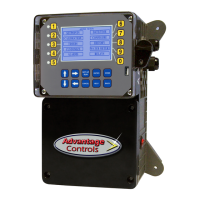8
Mounting Instructions
Select a mounting location that provides the operator easy access to the unit and a clear view of the
controls through the cover of the controller. The location should be convenient to grounded electrical
connections, the needed sample line plumbing and is on a stable vertical surface.
WARNING: Avoid locations that expose the controller to direct sunlight, vapors, vibration,
liquid spills or extreme temperatures; less than 0°F (-17.8°C) or greater than 120°F (50°C). EMI
(electromagnetic interference) from radio transmissions and electric motors can also cause damage
or interference and should be avoided.
Electrode Installation
MegaTron controllers may come congured for various circulating water systems. Listed below are
instructions for cooling tower and boiler typical installations. Your specic installation requirements may
dier but should conform to these instructions as much as possible for proper operation.
A. Cooling Tower
The standard probe(s) and/or ow assembly for cooling tower installations is constructed of schedule
80 PVC and supplied with 3/4” slip ttings for installing into a sample line. To insure proper operation
the sample line must have a ow rate of 3-10 gpm. Inlet pressure must be higher than outlet pressure in
order for water to ow past the electrode(s) to achieve the required rate. The probes are temperature
compensated for increased accuracy.
NOTES:
1. Installanisolationvalveoneithersideoftheowassemblysoelectrodescanbe
easily isolated for removal and cleaning.
2. A line strainer is recommended upstream from the probes to protect against fouling
and damage.
3. Mount pH or ORP electrodes vertically.
4. Green solution reference wire must be connected to either pH or ORP sensor. If both
pH & ORP are present on system card, only one solution reference connection is
needed.
5. Systemswithaowswitchrequire2-3gpmowratetooperateoutputs.
WARNINGS:
1. Electrodes are O-ring sealed, which if damaged will cause a leak.
2. Do not allow pH sensor tips to dry out, damage will occur.
3. Do not exceed a water temperature range of 32°F to 140°F.
4. Do not exceed a maximum pressure of 150 psi.

